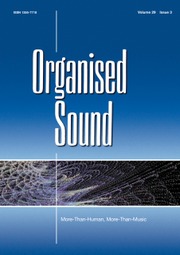No CrossRef data available.
Article contents
The Aural Aesthetics of Modernity: From the Philips Pavilion to EMPAC
Published online by Cambridge University Press: 04 September 2025
Abstract
In autumn 2023, the Curtis R. Priem Experimental Music and Performing Arts Center (EMPAC) at Rensselaer Polytechnic Institute presented Shifting Center, an exhibition that explored sound through geological formations, architecture, and cultural artefacts. Using spatialisation techniques such as higher-order ambisonics and wave field synthesis, the works created immersive and disorienting auditory experiences. Curators Vic Brooks and Nida Ghouse framed ‘shifting centre’ as a metaphor for dislocation, evoking feminist and political theories of marginalised peripheries and centralised power. While the exhibition was conceptually and technically ambitious, we argue that the aurality of EMPAC itself – marked by abstraction, isolation and immersion – ultimately muted its decolonial potential. By tracing a lineage of spatial audio from the 1958 Philips Pavilion, we examine how architectural acoustics shape the possibilities of what can be heard in EMPAC, limiting the aural and more-than-aural reception of works presented there.
Information
- Type
- Article
- Information
- Copyright
- © The Author(s), 2025. Published by Cambridge University Press


